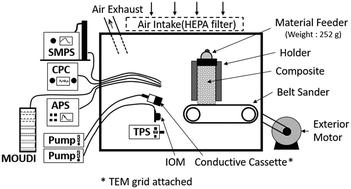当前位置:
X-MOL 学术
›
Environ. Sci.: Nano
›
论文详情
Our official English website, www.x-mol.net, welcomes your feedback! (Note: you will need to create a separate account there.)
Characterization of aerosolized particles from nanoclay-enabled composites during manipulation processes
Environmental Science: Nano ( IF 7.3 ) Pub Date : 2020-04-01 , DOI: 10.1039/c9en01211g Eun Gyung Lee 1 , Lorenzo Cena 2 , Jiwoon Kwon 3 , Ali Afshari 1 , HaeDong Park 2 , Gary Casuccio 4 , Kristin Bunker 4 , Traci Lersch 4 , Ashley Gall 5 , Huy Pham 5 , Alixandra Wagner 5 , Sushant Agarwal 5 , Cerasela Zoica Dinu 5 , Rakesh Gupta 5 , Sherri A Friend 1 , Todd A Stueckle 1
Environmental Science: Nano ( IF 7.3 ) Pub Date : 2020-04-01 , DOI: 10.1039/c9en01211g Eun Gyung Lee 1 , Lorenzo Cena 2 , Jiwoon Kwon 3 , Ali Afshari 1 , HaeDong Park 2 , Gary Casuccio 4 , Kristin Bunker 4 , Traci Lersch 4 , Ashley Gall 5 , Huy Pham 5 , Alixandra Wagner 5 , Sushant Agarwal 5 , Cerasela Zoica Dinu 5 , Rakesh Gupta 5 , Sherri A Friend 1 , Todd A Stueckle 1
Affiliation

|
Manufacturing, processing, use, and disposal of nanoclay-enabled composites potentially lead to the release of nanoclay particles from the polymer matrix in which they are embedded; however, exposures to airborne particles are poorly understood. The present study was conducted to characterize airborne particles released during sanding of nanoclay-enabled thermoplastic composites. Two types of nanoclay, Cloisite® 25A and Cloisite® 93A, were dispersed in polypropylene at 0%, 1%, and 4% loading by weight. Zirconium aluminum oxide (P100/P180 grits) and silicon carbide (P120/P320 grits) sandpapers were used to abrade composites in controlled experiments followed by real-time and offline particle analyses. Overall, sanding the virgin polypropylene with zirconium aluminum oxide sandpaper released more particles compared to silicon carbide sandpaper, with the later exhibiting similar or lower concentrations than that of polypropylene. Thus, a further investigation was performed for the samples collected using the zirconium aluminum oxide sandpaper. The 1% 25A, 1% 93A, and 4% 93A composites generated substantially higher particle number concentrations (1.3–2.6 times) and respirable mass concentrations (1.2–2.3 times) relative to the virgin polypropylene, while the 4% 25A composite produced comparable results, regardless of sandpaper type. It was observed that the majority of the inhalable particles were originated from composite materials with a significant number of protrusions of nanoclay (18–59%). These findings indicate that the percent loading and dispersion of nanoclay in the polypropylene modified the mechanical properties and thus, along with sandpaper type, affected the number of particles released during sanding, implicating the cause of potential adverse health effects.
中文翻译:

在操作过程中表征纳米粘土复合材料的雾化颗粒
纳米粘土复合材料的制造、加工、使用和处置可能会导致纳米粘土颗粒从它们嵌入的聚合物基质中释放出来;然而,人们对空气中颗粒物的暴露知之甚少。本研究旨在表征纳米粘土启用的热塑性复合材料在打磨过程中释放的气载颗粒。两种类型的纳米粘土,Cloisite® 25A 和 Cloisite® 93A,以 0%、1% 和 4% 的重量负载量分散在聚丙烯中。氧化锆铝(P100/P180 粒度)和碳化硅(P120/P320 粒度)砂纸用于在受控实验中研磨复合材料,然后进行实时和离线颗粒分析。总的来说,与碳化硅砂纸相比,用氧化铝锆砂纸打磨原生聚丙烯释放出更多颗粒,后者表现出与聚丙烯相似或更低的浓度。因此,对使用氧化锆铝砂纸收集的样品进行了进一步的研究。相对于纯聚丙烯,1% 25A、1% 93A 和 4% 93A 复合材料产生的颗粒数浓度(1.3-2.6 倍)和可吸入质量浓度(1.2-2.3 倍)明显更高,而 4% 25A 复合材料产生的可比性结果,无论砂纸类型如何。据观察,大部分可吸入颗粒来自复合材料,具有大量纳米粘土突起 (18-59%)。这些发现表明,纳米粘土在聚丙烯中的负载百分比和分散度改变了机械性能,因此,与砂纸类型一起,
更新日期:2020-04-01
中文翻译:

在操作过程中表征纳米粘土复合材料的雾化颗粒
纳米粘土复合材料的制造、加工、使用和处置可能会导致纳米粘土颗粒从它们嵌入的聚合物基质中释放出来;然而,人们对空气中颗粒物的暴露知之甚少。本研究旨在表征纳米粘土启用的热塑性复合材料在打磨过程中释放的气载颗粒。两种类型的纳米粘土,Cloisite® 25A 和 Cloisite® 93A,以 0%、1% 和 4% 的重量负载量分散在聚丙烯中。氧化锆铝(P100/P180 粒度)和碳化硅(P120/P320 粒度)砂纸用于在受控实验中研磨复合材料,然后进行实时和离线颗粒分析。总的来说,与碳化硅砂纸相比,用氧化铝锆砂纸打磨原生聚丙烯释放出更多颗粒,后者表现出与聚丙烯相似或更低的浓度。因此,对使用氧化锆铝砂纸收集的样品进行了进一步的研究。相对于纯聚丙烯,1% 25A、1% 93A 和 4% 93A 复合材料产生的颗粒数浓度(1.3-2.6 倍)和可吸入质量浓度(1.2-2.3 倍)明显更高,而 4% 25A 复合材料产生的可比性结果,无论砂纸类型如何。据观察,大部分可吸入颗粒来自复合材料,具有大量纳米粘土突起 (18-59%)。这些发现表明,纳米粘土在聚丙烯中的负载百分比和分散度改变了机械性能,因此,与砂纸类型一起,



























 京公网安备 11010802027423号
京公网安备 11010802027423号